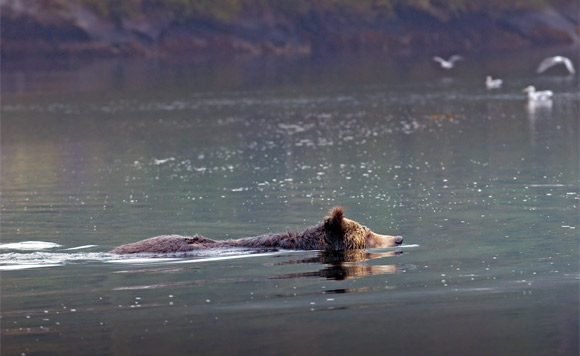– by Chris Genovali –
When Douglas Neasloss, Resource Stewardship Director and former Chief Counselor of the Kitasoo/Xai’xais First Nation, first noticed grizzly bears on coastal islands in B.C.’s Great Bear Rainforest, he was concerned. Although mainland parts of his traditional territory contained both grizzly and black bears, only black bears were known to live on the islands. Neasloss told provincial government biologists, but was dismissed because “he was not a biologist.” Determined, he found allies at the Raincoast Conservation Foundation and University of Victoria who recognized the value of this local knowledge and could meaningfully combine it with science.
Recently, wildlife scientists published a study in the international peer-reviewed journal, PLOS ONE, affirming that Neasloss was right all along. Researchers from the Kitasoo/Xais’xais’ own Spirit Bear Research Foundation, Raincoast Conservation Foundation, and the Hakai-Raincoast Lab at UVic conducted a two-year survey of 14 islands in the Great Bear Rainforest – outside the range the B.C. government recognizes in its management of grizzlies. Ten islands showed evidence of resident grizzly bears.
Importantly, the results showed the presence of females and young cubs, which generally move little in a given season. This suggests that grizzly bears are resident on the islands and not simply passing through. The scientists used a combination of non-invasive techniques to study grizzly bear distribution in the area. Non-invasively snagged hair provided DNA for genetic analyses, revealing the species, sex, and individual identity of bears. Remote cameras took photos of bears as they investigated the snagging stations.
“Our method drew from 10,000 years of place-based history and the cutting edge of genetic analyses. This let us draw conclusions with more detail, and over longer time periods, than either method could alone,” said lead author Christina Service, a PhD student at UVic and scientist with the Spirit Bear Research Foundation and Raincoast Conservation Foundation.
On one hand, this research suggests underlying and potentially significant environmental change. On the other, the presence of grizzlies on islands could trigger new land protection because provincial policy requires high quality grizzly habitat to be protected throughout the Great Bear Rainforest. “Against a backdrop of eroding funding for, and public confidence in, the ability of provincial and federal governments to steward these ecosystems, the results of our study raise important questions about whether there is adequate protection for the Great Bear Rainforest’s numerous island environments and the wildlife that inhabit and depend on them,” said Dr. Chris Darimont, Science Director at Raincoast and Hakai-Raincoast professor at UVic.
Chris Genovali is Executive Director of Raincoast Conservation Foundation. Photo by Andrew S. Wright / www.cold-coast.com.




